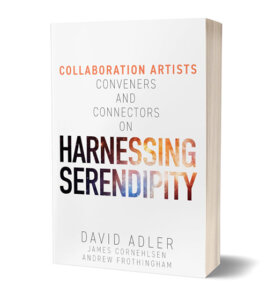
Andrew Lacanienta, a senior strategist at George P. Johnson, is one of the scores of “collaboration artists,” “conveners,” and “connectors” interviewed in the book Harnessing Serendipity by David Adler, James Cornehlsen, and Andrew Frothingham.
Harnessing Serendipity is not a book to be consumed all at once — it belongs next to your laptop so you can consult it regularly for inspiration. There are multiple insights for event organizers from each one of the 66 people — called “collaboration artists,” “conveners,” and “connectors” — whom David Adler, along with coauthors James Cornehlsen and Andrew Frothingham, spoke to for this book.
Adler, who founded the event media company BizBash, and his coauthors profiled musicians, artists, diplomats, event designers, and thought leaders, organizing them individually into six thematic buckets — awareness, belonging, creativity, curiosity, and empathy. Each collaboration artist speaks to the deeper and more far-reaching aspects of event design. I’ve loosely excerpted from one of those profiles, below, to give you a taste of the book:

Harnessing Serendipity contains multiple insights for event organizers.
Andrew Lacanienta is living proof that the events and experience design industry is serious about reaping the benefits of advanced study of human interaction.
Today, he’s a senior strategist at George P. Johnson in the San Francisco Bay Area. Prior to that, he was a freelance creative director and strategist at Drury Design. And prior to that, he was an assistant professor in the department of experience industry management at California Polytechnic State University-San Luis Obispo. He’s articulate about the principles of outcome-based design, observation, curiosity, deep listening, ideation, real-time prototyping, iteration, and much more.
“Experience design is the process of intentionally orchestrating experience to provide opportunities for participants to co-create or participate with one another and sustain interactions that lead to results desired by both participants and the designer,” Lacanienta said.
“In the event space, we often think about experience and it’s always something extraordinary,” he continues. “It’s always a mind-blowing ‘aha’ moment. But if every experience was extraordinary, you’d be exhausted by 8 o’clock in the morning.”
The department of experience design and management at Brigham Young University, Lacanienta said, “did some cutting-edge research and created a typology of experiences that goes from prosaic to transformative.”
Prosaic experiences “are autopilot-type experiences, like brushing your teeth. It’s not particularly memorable,” he said. “We just do it. The second level is ‘mindful experiences.’ You’re thinking a little bit more about what you’re doing. Third is ‘memorable experiences.’ Once an experience becomes memorable, there is emotion involved.”
The fourth level is meaningful experiences. “An experience becomes meaningful when discovery is involved,” Lacanienta said, “such as when you’re discovering something new, you’re learning something about yourself, etc.”
The fifth and highest level is transformative experiences, which he said, involves “behavior change or a paradigm shift, or something’s changing.”
Once you understand the different types of experiences, according to Lacanienta, you can intentionally design for them. Perhaps a gathering starts with a prosaic experience — then the next experience could be memorable. After that, a meaningful experience follows. While not all experiences can be extraordinary, you can intentionally design those different touches in a way that meets the desired outcomes and goals.
Lacanienta said that academic research also led to the theory of structured experience. “A key characteristic of a structured experience is that it has a distinct beginning and ending, whether it lasts for seconds or hours. Within this theory of structured experiences, there are three types of experience: immersion, absorption, and engagement. Immersion activities are experiences that require a balance of challenge and skill, or action and reaction — chess and fencing are good examples.”
An absorption experience is a sensory experience of relaxation and pleasure — like getting a massage or doing a wine-tasting, he said. “Engagement experiences are any type of experience that follows an unfolding narrative or story. It could be following a sporting event, or watching a theatrical play, or reading a book.” But the experience types are not mutually exclusive — some are both immersion and engagement experiences.
[Lacanienta goes into more depth explaining each experience and finds the framework useful for experience designers and event planners, who can say] “’Ok, what is this experience? What are we really trying to do here? Are we trying to elicit an experience that’s relaxing and pleasurable? Are we trying to tell a story or are we trying to facilitate a challenge for our participants?’ People are starting to become hungry for this. Passive entertainment, passive learning, passive in general is going out the door. We’ve got this giant technology bit happening where everyone’s hyper-connected and everything is at your fingertips all the time. But I think we’re going to see an increase in disconnection because people are hungry for human interaction.”
Learn more about the book at harnessingserendipity.com.
Michelle Russell is editor in chief of Convene.
